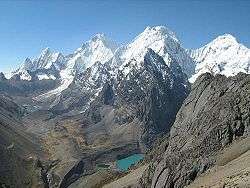Department of Huánuco
Huánuco (Spanish pronunciation: [ˈwanuko]) is a department in central Peru.[1] It is bordered by the La Libertad, San Martín, Loreto and Ucayali regions in the north, the Ucayali Region in the east, the Pasco Region in the south and the Lima and Ancash regions in the west. Its capital is the city Huánuco.
Department of Huánuco | |
|---|---|
Region | |
 The Huayhuash mountain range with Yerupajá, one of the highest peaks of Peru | |
 Flag  Seal | |
.svg.png) Location of the Department of Huánuco in Peru | |
| Country | Peru |
| Subdivisions | 11 provinces and 76 districts |
| Largest city | Huánuco |
| Capital | Huánuco |
| Government | |
| • Governor | Rubén Alva Ochoa (2015–2018) |
| Area | |
| • Total | 36,848.85 km2 (14,227.42 sq mi) |
| Highest elevation | 3,839 m (12,595 ft) |
| Lowest elevation | 167 m (548 ft) |
| Population (2005 Census) | |
| • Total | 730,871 |
| • Density | 20/km2 (51/sq mi) |
| UBIGEO | 10 |
| Dialing code | 062 |
| ISO 3166 code | PE-HUC |
| Principal resources | – |
| Poverty rate | 78.9% |
| Percentage of Peru's GDP | 1% |
| Website | www.regionhuanuco.gob.pe |

Huánuco has a rough topography comprising parts of the Sierra and the High Jungle (mountain rim) regions. Being equidistant from the north and the south of the country, it has the privilege of having a mild weather with an average annual temperature of 20°C (68°F).
This region is important for its geographical location, history, and for the richness of its land, where the presence of man goes back to ancient times. El Hombre de Lauricocha (Man of Lauricocha) is among the most distinctive examples, dating from 10,000 BC, as well as Kotosh, where vestiges of the oldest settlement in the Americas (4200 BC) took place.
Several ethnic groups inhabited this region. However, after a severe resistance, they started to incorporate as part of the Inca empire. Huánuco then became part of the Cusco-Cajamarca-Cusco route.
In the beginning of the 19th century, during the emancipation process, Huánuco was one of the first cities to promote Peru's independence. Moreover, a first oath took place in this city on December 15, 1820, after several uprisings in Huamalíes, Huallanca and Ambo.
Political division

The region is divided into 11 provinces (Spanish: provincias, singular: provincia), which are composed of 75 districts (distritos, singular: distrito).
The provinces, with their capitals in parentheses, are:
The People
Languages
According to the 2007 Peru Census, the language learned first by most of the residents was Spanish (70.92%) followed by Quechua (28.56%). The Quechua variety spoken in Huánuco is Huánuco Quechua. The following table shows the results concerning the language learnt first in the Huánuco Region by province:[2]
| Province | Quechua | Aymara | Asháninka | Another native language | Spanish | Foreign language | Deaf or mute | Total |
|---|---|---|---|---|---|---|---|---|
| Ambo | 13,141 | 30 | 9 | 5 | 38,840 | 2 | 86 | 52,113 |
| Dos de Mayo | 17,399 | 20 | 5 | 11 | 26,102 | 6 | 91 | 43,634 |
| Huacaybamba | 14,920 | 19 | 2 | 2 | 3,869 | 1 | 106 | 18,919 |
| Huamalies | 32,873 | 44 | 6 | 6 | 28,511 | 4 | 226 | 61,670 |
| Huanuco | 60,281 | 177 | 73 | 62 | 192,886 | 54 | 369 | 253,902 |
| Leoncio Prado | 8,990 | 78 | 30 | 82 | 99,915 | 19 | 178 | 109,292 |
| Marañon | 6,073 | 8 | 4 | 7 | 18,367 | - | 82 | 24,541 |
| Pachitea | 26,229 | 56 | 9 | 14 | 29,415 | - | 107 | 55,830 |
| Puerto Inca | 1,582 | 81 | 545 | 731 | 25,541 | 2 | 59 | 28,541 |
| Lauricocha | 3,415 | 17 | 4 | 8 | 29,481 | - | 23 | 32,948 |
| Yarowilca | 18,308 | 30 | 6 | 2 | 11,633 | - | 49 | 30,028 |
| Total | 203,211 | 560 | 693 | 930 | 504,560 | 88 | 1,376 | 711,418 |
| % | 28.56 | 0.08 | 0.10 | 0.13 | 70.92 | 0.01 | 0.19 | 100.00 |
Places of interest
- Awkillu Waqra
- Awkimarka
- El Sira Communal Reserve
- Qillqay Mach'ay
- Huayhuash mountain range
References
- Official website of INEI
- inei.gob.pe Archived 2013-01-27 at the Wayback Machine INEI, Peru, Censos Nacionales 2007
External links
